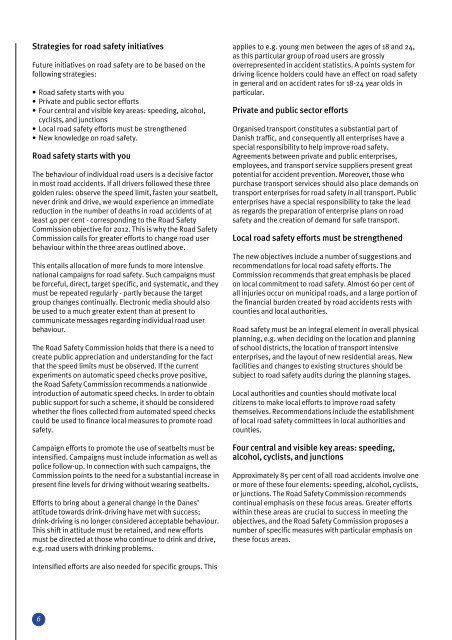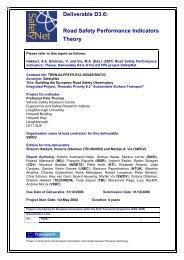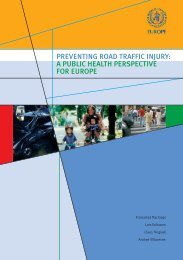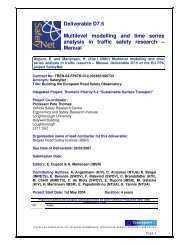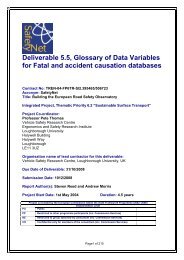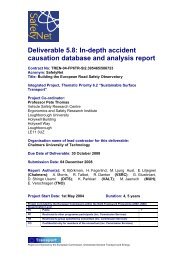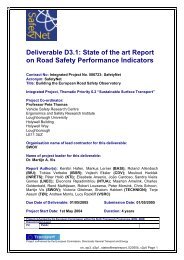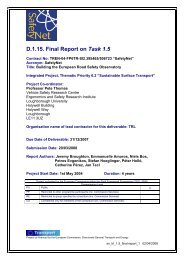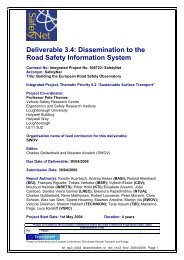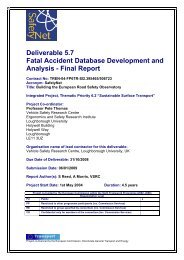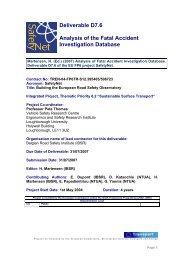Every Accident is One Too Many Every Accident is One ... - UNECE
Every Accident is One Too Many Every Accident is One ... - UNECE
Every Accident is One Too Many Every Accident is One ... - UNECE
You also want an ePaper? Increase the reach of your titles
YUMPU automatically turns print PDFs into web optimized ePapers that Google loves.
Strategies for road safety initiatives<br />
Future initiatives on road safety are to be based on the<br />
following strategies:<br />
• Road safety starts with you<br />
• Private and public sector efforts<br />
• Four central and v<strong>is</strong>ible key areas: speeding, alcohol,<br />
cycl<strong>is</strong>ts, and junctions<br />
• Local road safety efforts must be strengthened<br />
• New knowledge on road safety.<br />
Road safety starts with you<br />
The behaviour of individual road users <strong>is</strong> a dec<strong>is</strong>ive factor<br />
in most road accidents. If all drivers followed these three<br />
golden rules: observe the speed limit, fasten your seatbelt,<br />
never drink and drive, we would experience an immediate<br />
reduction in the number of deaths in road accidents of at<br />
least 40 per cent - corresponding to the Road Safety<br />
Comm<strong>is</strong>sion objective for 2012. Th<strong>is</strong> <strong>is</strong> why the Road Safety<br />
Comm<strong>is</strong>sion calls for greater efforts to change road user<br />
behaviour within the three areas outlined above.<br />
Th<strong>is</strong> entails allocation of more funds to more intensive<br />
national campaigns for road safety. Such campaigns must<br />
be forceful, direct, target specific, and systematic, and they<br />
must be repeated regularly - partly because the target<br />
group changes continually. Electronic media should also<br />
be used to a much greater extent than at present to<br />
communicate messages regarding individual road user<br />
behaviour.<br />
The Road Safety Comm<strong>is</strong>sion holds that there <strong>is</strong> a need to<br />
create public appreciation and understanding for the fact<br />
that the speed limits must be observed. If the current<br />
experiments on automatic speed checks prove positive,<br />
the Road Safety Comm<strong>is</strong>sion recommends a nationwide<br />
introduction of automatic speed checks. In order to obtain<br />
public support for such a scheme, it should be considered<br />
whether the fines collected from automated speed checks<br />
could be used to finance local measures to promote road<br />
safety.<br />
Campaign efforts to promote the use of seatbelts must be<br />
intensified. Campaigns must include information as well as<br />
police follow-up. In connection with such campaigns, the<br />
Comm<strong>is</strong>sion points to the need for a substantial increase in<br />
present fine levels for driving without wearing seatbelts.<br />
Efforts to bring about a general change in the Danes’<br />
attitude towards drink-driving have met with success;<br />
drink-driving <strong>is</strong> no longer considered acceptable behaviour.<br />
Th<strong>is</strong> shift in attitude must be retained, and new efforts<br />
must be directed at those who continue to drink and drive,<br />
e.g. road users with drinking problems.<br />
applies to e.g. young men between the ages of 18 and 24,<br />
as th<strong>is</strong> particular group of road users are grossly<br />
overrepresented in accident stat<strong>is</strong>tics. A points system for<br />
driving licence holders could have an effect on road safety<br />
in general and on accident rates for 18-24 year olds in<br />
particular.<br />
Private and public sector efforts<br />
Organ<strong>is</strong>ed transport constitutes a substantial part of<br />
Dan<strong>is</strong>h traffic, and consequently all enterpr<strong>is</strong>es have a<br />
special responsibility to help improve road safety.<br />
Agreements between private and public enterpr<strong>is</strong>es,<br />
employees, and transport service suppliers present great<br />
potential for accident prevention. Moreover, those who<br />
purchase transport services should also place demands on<br />
transport enterpr<strong>is</strong>es for road safety in all transport. Public<br />
enterpr<strong>is</strong>es have a special responsibility to take the lead<br />
as regards the preparation of enterpr<strong>is</strong>e plans on road<br />
safety and the creation of demand for safe transport.<br />
Local road safety efforts must be strengthened<br />
The new objectives include a number of suggestions and<br />
recommendations for local road safety efforts. The<br />
Comm<strong>is</strong>sion recommends that great emphas<strong>is</strong> be placed<br />
on local commitment to road safety. Almost 60 per cent of<br />
all injuries occur on municipal roads, and a large portion of<br />
the financial burden created by road accidents rests with<br />
counties and local authorities.<br />
Road safety must be an integral element in overall physical<br />
planning, e.g. when deciding on the location and planning<br />
of school d<strong>is</strong>tricts, the location of transport intensive<br />
enterpr<strong>is</strong>es, and the layout of new residential areas. New<br />
facilities and changes to ex<strong>is</strong>ting structures should be<br />
subject to road safety audits during the planning stages.<br />
Local authorities and counties should motivate local<br />
citizens to make local efforts to improve road safety<br />
themselves. Recommendations include the establ<strong>is</strong>hment<br />
of local road safety committees in local authorities and<br />
counties.<br />
Four central and v<strong>is</strong>ible key areas: speeding,<br />
alcohol, cycl<strong>is</strong>ts, and junctions<br />
Approximately 85 per cent of all road accidents involve one<br />
or more of these four elements: speeding, alcohol, cycl<strong>is</strong>ts,<br />
or junctions. The Road Safety Comm<strong>is</strong>sion recommends<br />
continual emphas<strong>is</strong> on these focus areas. Greater efforts<br />
within these areas are crucial to success in meeting the<br />
objectives, and the Road Safety Comm<strong>is</strong>sion proposes a<br />
number of specific measures with particular emphas<strong>is</strong> on<br />
these focus areas.<br />
Intensified efforts are also needed for specific groups. Th<strong>is</strong><br />
6


